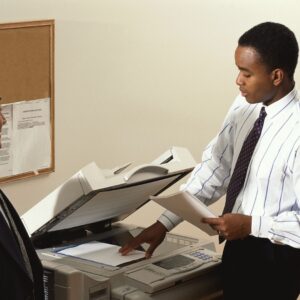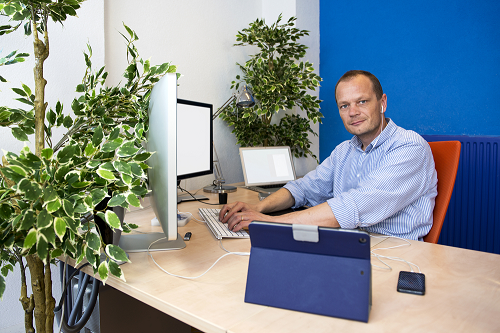2019 marked the 60th anniversary of the first commercial office copier. Although the technology was ostensibly invented over 20 years before, in 1938, getting a truly operational machine wouldn’t happen until Xerox Corporation managed to develop the Xerox 914.
This first commercial model from Xerox was large, cumbersome and weighed nearly 650 pounds. Unlike even the larger office copy machines we see today, it was as big as two washing machines. But, despite its size and propensity for catching on fire, it began a revolution in duplication.
Static Electricity and Castor Oil
Way back on October 22, 1938, Chester Carlson used light, dry powder and static electricity he created with a handkerchief to make the first xerographic image, or copy. The process was eventually called xerography, meaning “dry writing.”
According to Wikipedia,

“Chester Floyd Carlson was an American physicist, inventor, and patent attorney born in Seattle, Washington. He is best known for having invented the process of electrophotography, which produced a dry copy rather than a wet copy, as was produced by the mimeograph process.”
This dry copy process was a radical departure from the existing common duplicating process, mimeograph. Many Baby Boomers can still recall the distinctive scent of mimeograph copies originating from the school office. Not that it was a pleasant odor, mind you, but it was distinctive and came from the sulfated castor oil that served as an emulsion.
The venerable old mimeograph machine that originated in 1886 was slowly being replaced during the 1960s by the upstart xerographic machine. The mimeograph process had become popular since it was far more cost-effective than traditional printing, one of the only reliable alternatives before xerography and the office copiers we know today.
Because there was no typesetting involved, just one individual with a typewriter and the necessary equipment could print numerous copies of an original document.
Ditto For the Spirit Duplicator
However, there was another technological hold out that came into being about four decades after the mimeograph – the spirit duplicator or, as many remember it: the ditto machine.
Using a process invented in 1923 by Wilhelm Ritzerfeld, these incredibly handy – and hand-cranked – wonders could produce about 40 or so good copies from one master before the copies gradually become paler. In the United States and most of the civilized world, the best-known manufacturer of spirit duplicators was the Ditto Corporation of Illinois.
And, much like the Xerox Corporation and their office copiers, the Ditto Corporation brand name became a generic name for spirit duplicators in general.
[William Ritzerfeld’s Patent Drawing for his Process for Multiplying Records]
These spirit duplicators, or Ditto machines, were used along with the mimeograph mainly by schools, churches, clubs, and other small organizations. Despite the limited number of copies one could make from an original, the reasonable image quality along with the low cost of copying made it a popular machine.
Ditto “purple” became a staple color of print in thousands of schools and other organizations in the last half of the 20th century. Along with the familiar odor of methyl alcohol that became associated with ditto copies for millions of schoolchildren.
Paper and Ink
What may seem to be a technological reversal of sorts, inkjet printing came into being long before PCs, but in a limited role.
The concept of inkjet printing originated in the first half of the 20th century, with the technology being more fully developed by the early 1950s. In the late 1970s, inkjet printers were being made that could reproduce digital images generated by computers.
Essentially, inkjet printing uses a process to recreate a digital image by propelling droplets of ink onto paper and or plastic substrates. With the development of “all-in-one” machines, inkjet printers serve as office copiers as well as printers and fax machines.
The advent of the all-in-one inkjet printer also meant that “office copiers” were now affordable for the small business owner as well as consumers at home. The rise in demand and the reduction in size of the average machine decreased the costs and increased affordability.
By the 2010s, these machines were routinely selling for less than $100.
Lasers, Electrostatic Charges, and Black Powder
While that may sound like a description of the film Cowboys and Aliens, those are actually the key elements of laser printing, the newer, “hipper” version of xerography.
An entry at Wikipedia tells us that,
“As with digital photocopiers, laser printers employ a xerographic printing process. Laser printing differs from traditional xerography as implemented in analog photocopiers in that in the latter, the image is formed by reflecting light off an existing document onto the exposed drum.”
The process was invented at Xerox PARC, the research and development company in Palo Alto, California that was originally formed as a subsidiary of Xerox. In 1973 the Xerox 1200 became “the first commercial laser printer” in the world.
And history was made once again.
By 1984, when the first Hewlett-Packard LaserJet printer was developed, the simple task of “making a copy” took on a whole new dimension. And the humble office copier had now entered the digital age.
The Office Copier Today
Office copiers are still quite ubiquitous and the need to make copies has not diminished despite the prevalence of digital formats for documents.
According to a product review article at Business.com,
“Despite being in the digital age, there are still reasons why businesses should invest in a multifunction printer. Not every customer or partner wants to receive digital records. Also, technology fails at times. Those moments can put your business in a tight spot. It’s always a good idea to have hard copies available in case of tech emergencies. A good quality, multifunction printer and copier can produce the documents your business needs efficiently so no time is wasted.”
While we may still think of these modern version as mere “office copiers”, more often than not they actually multifunction printers (MFPs) or multifunction copiers (MFCs), which are also called all-in-one printers.
These “office copiers” not only copy, print, fax and scan, but users can print digital files and create copies from the same machine.
And the evolution of office copier technology continues!
The Rise of the Global Copier Market: Sustained Demand in a Digital Age
The copier industry has transformed into a global powerhouse, driven by evolving workplace needs and technological advancements. While digital alternatives have become more prevalent, the copier market was valued at $12.18 billion in 2021 and is projected to reach $13.34 billion by 2028. This growth underscores the ongoing demand for multifunction devices that can handle high-volume document processing, especially in industries reliant on physical documentation, such as healthcare, legal, and education. As businesses continue to balance digital workflows with physical copies, the market remains robust, fueled by the incorporation of features like mobile printing and cloud connectivity.
Sustainable Innovation: Eco-Friendly Features in Modern Copiers
Environmental sustainability has become a priority in copier design, with manufacturers increasingly focusing on energy efficiency and eco-friendly materials. Many modern copiers now meet ENERGY STAR certifications, contributing to reduced office energy costs and supporting corporate sustainability goals. Studies indicate that office equipment accounts for roughly 7% of commercial energy use in the U.S., with energy-efficient upgrades potentially cutting these expenses by up to 50%. Additional features, such as automatic duplex printing and low-energy sleep modes, are helping companies minimize waste and manage resources more responsibly, demonstrating the industry’s response to the growing demand for greener office solutions.
The Impact of Cloud Integration on Document Management
Cloud-enabled copiers and printers are revolutionizing document workflows by enabling seamless access and remote capabilities. Research shows that companies adopting cloud-connected devices report a 28% boost in productivity, driven by easier access to shared documents and enhanced collaboration. Beyond efficiency, cloud integration also supports secure data storage and file sharing, which is increasingly important in data-sensitive sectors. As businesses adopt cloud-based solutions, modern copiers are evolving into essential hubs for secure and efficient document management, positioning them as more than just devices for printing and copying but as pivotal tools for modernized workplace operations.
FAQ Section: Evolution and Impact of Office Copiers
1. When was the first commercial office copier invented?
The first commercial office copier, the Xerox 914, was introduced in 1959. Although Chester Carlson invented xerography in 1938, it wasn’t until Xerox developed this model that office copiers became widespread. Weighing nearly 650 pounds, the Xerox 914 was a revolutionary machine, albeit bulky and prone to overheating. Despite these drawbacks, it set the stage for the modern office copiers we use today.
2. How did xerography change the way documents were copied?
Xerography, developed by Chester Carlson, revolutionized document duplication by using static electricity and dry powder to create copies. Before xerography, the mimeograph was the go-to method, which involved messy, wet processes. Xerography’s “dry writing” method was cleaner and more efficient, making it the foundation for modern copiers and printers.
3. What was the mimeograph machine, and how did it work?
The mimeograph machine, popularized in the late 19th century, was an early form of duplicating documents. It used ink and a stencil to print copies, which was more cost-effective than traditional printing. However, the process was labor-intensive and messy. Mimeographs were gradually replaced by xerographic machines in the 1960s as more efficient copying technologies emerged.
4. What was the significance of the Ditto machine in schools and small organizations?
The Ditto machine, also known as a spirit duplicator, became a staple in schools and small organizations for producing low-cost copies. Introduced in 1923, this hand-cranked device could produce up to 40 copies from a single master. The machine’s purple ink and the distinctive smell of methyl alcohol it emitted are nostalgic for many who grew up in the mid-20th century.
5. How did inkjet printing revolutionize office copiers?
Inkjet printing, which emerged in the late 1970s, was a game-changer for office copiers. It allowed for the creation of affordable, all-in-one devices that could print, copy, scan, and fax. The technology propelled office copiers into the mainstream, making them accessible to small businesses and home offices. By the 2010s, inkjet printers were available for under $100, marking a significant milestone in copier affordability.
6. What are the key components of a laser printer, and how do they differ from earlier copiers?
Laser printers, developed in the 1970s, use lasers, electrostatic charges, and black toner powder to create images. Unlike traditional xerography, where light reflects off documents onto a drum, laser printers use direct imaging to produce precise copies. The first commercial laser printer, the Xerox 1200, was introduced in 1973, and by 1984, the Hewlett-Packard LaserJet brought this technology to the masses, further advancing office printing capabilities.
7. Why are multifunction printers (MFPs) essential for modern offices?
Multifunction printers (MFPs) have become essential in modern offices due to their versatility. These devices combine copying, printing, scanning, and faxing into one machine, streamlining office workflows and saving space. In today’s digital age, MFPs also support printing from digital files, making them indispensable for both small businesses and large corporations.
8. How did the Xerox 914 impact the copier industry?
The Xerox 914 was the first widely successful commercial copier, marking a turning point in the industry. Its ability to produce multiple copies quickly and efficiently revolutionized office work. Despite its tendency to overheat, the Xerox 914’s impact was profound, leading to the eventual dominance of Xerox in the copier market and setting the standard for future machines.
9. What are the environmental considerations for using modern office copiers?
Modern office copiers are increasingly designed with environmental sustainability in mind. Features like energy-saving modes, recyclable materials, and eco-friendly toners reduce their carbon footprint. Businesses are encouraged to use copiers efficiently, recycle used cartridges, and opt for machines with lower energy consumption to minimize their environmental impact.
10. How has digital technology influenced the evolution of office copiers?
Digital technology has dramatically influenced the evolution of office copiers. Today’s copiers are often part of larger multifunctional systems that integrate with office networks, support cloud storage, and offer advanced security features. This shift from analog to digital has made copiers more versatile, allowing them to handle a broader range of tasks, from simple copying to complex document management and workflow automation.





